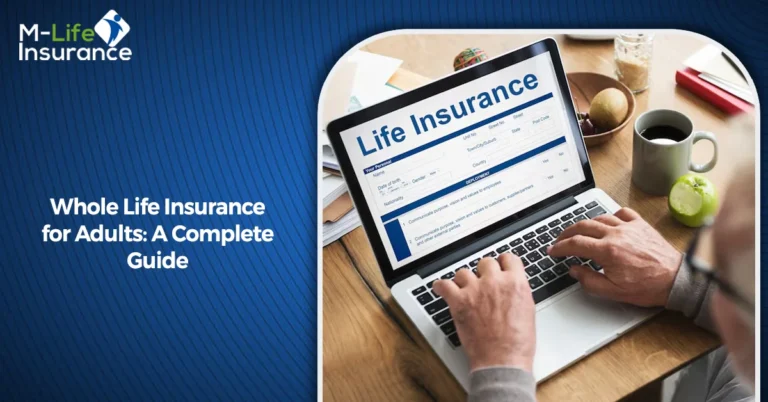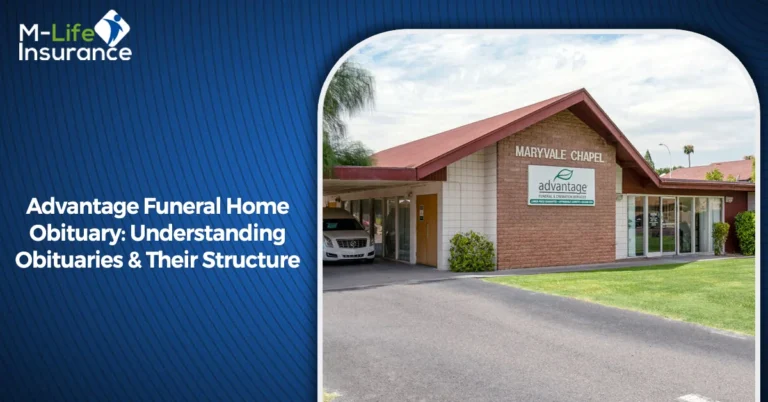Last Updated on: May 29th, 2025
- Licensed Agent
- - @M-LifeInsurance
Life insurance is the most important financial decision you have to make in your life.Its not just about protecting your money but It provides peace of mind and financial security for your loved ones after your life. But, with so many types of life insurance and companies offering different plans, it’s a bit confusing to choose what is the best option.What kind of policy do I really need?” or “How do I even start?”
That’s why we created this simple guide to walk you through every step of choosing the right life insurance for you. You will get to know how much coverage you need and also get to understand different types of policies and picking a trustworthy insurance provider.
Why Life Insurance Matters
Life insurance is a smart and caring way to protect your family. If something will happen to you unexpectedly or a sudden death, life insurance will help your family handle major expenses like the cost of funereal, unpaid debts, home loans, or even your children’s future education. It takes away the financial burden during an already difficult time.
When thinking about life insurance, finding a plan that matches your needs and budget is important. The right policy can give you comfort, knowing your family will be okay if anything happens to you. Learning about your options now can save a lot of worry later and help you make the best choice for your future.
What Are the Main Life Insurance Types?
Before choosing a policy, it’s very important to understand the different life insurance types. Here we will break down the life insurance types;
1. Term Life Insurance
Term life insurance is an easy and affordable coverage for a limited number of years like 10, 20, or 30 years. If you die during that time, your loved ones receive a death benefit to help cover things like funeral costs,your home loan, or other bills. Term life insurance is best for people who want protection while they have important financial responsibilities, like raising kids or paying off a house loan.
2. Whole Life Insurance
Whole life insurance will give you lifelong coverage,that will make it a good option for those who focus on long-term financial planning. Unlike term life, it builds cash savings over time.Whole life insurance might not fit everyone’s budget because it is way more expensive than the term life.. While the cost is higher, the lifelong protection and savings component make it a valuable choice for many policyholders.
3. Universal Life Insurance
Universal life insurance gives you coverage for your whole life and it is more flexible than other types. You can change how much you pay and how much your family would get after you pass away. It also builds cash value over time. This type of insurance is a good choice if you want lifelong coverage and the freedom to make changes as your needs change. However, it can be harder to understand and usually costs more. Still, it’s a good option for people who want both long-term protection and the chance to grow their money.
4. Final Expense Insurance
Final expense insurance is a type of life insurance designed mainly for seniors. It offers a small death benefit, usually ranging from $2,000 to $25,000, to help cover funeral expenses, medical bills, or other end-of-life costs.
It is best suited for individuals who want to ease the financial burden on their loved ones without paying for a large policy. One of its biggest advantages is easy approval, many plans from this insurance type don’t require a medical exam and are affordable on a fixed income.
5. Group Life Insurance
Group life insurance is a type of life insurance you get through your job. It’s usually free or very low-cost, and signing up is very easy and also there is no medical exam in this insurance.
It’s a good choice if you want some extra life insurance while you’re working. It helps give peace of mind without adding to your monthly bills.
But there are a few downsides. The coverage amount is often small, and you don’t get many choices in how the policy works. Also, if you leave your job, the insurance usually ends, so it doesn’t go with you.
Life Insurance Types Chart
| Policy Type | Duration | Builds Cash Value | Premiums | Best For |
| Term Life | 10–30 years | No | Low | Budget-conscious families |
| Whole Life | Lifetime | Yes | High | Long-term wealth planning |
| Universal Life | Lifetime | Yes | Flexible | High-income earners |
| Final Expense | Lifetime | No | Moderate | Seniors with burial needs |
| Group Life | Varies | No | Low/Free | Employees |
How To Choose Life Insurance Amount
Figuring out how much life insurance you need depends on your financial situation and goals. Here’s a simple and easy way to start:
1. Income Replacement
Start by thinking about how many years your family would need financial support if you were no longer there. Multiply your annual income by the number of years your family would need financial support (commonly 10–15 years).
2. Debt Coverage
Next add up any outstanding debts such as a house loans, car loans, and credit cards.Paying off these debts can relieve your family from financial stress
3. Future Expenses
Don’t forget to think about future costs. This includes things like college tuition or retirement for your spouse.These expenses can add up, so it’s important to plan before.
How Much Does Life Isurance Cost?
4. Final Expenses
Last thing to consider is that you have to estimate funeral costs and medical bills, usually between $7,000 and $15,000.
How to Choose Life Insurance Company
Choosing a trustworthy insurance company is as important as picking the right policy. Here are some important things to consider;
1. Financial Strength
Look at ratings from companies like A.M. Best, Moody’s, and Standard & Poor’s. These ratings show if the insurance company is strong enough to pay out claims when needed.
2. Customer Service
Read customer reviews and complaints. A responsive insurer makes filing claims and managing your policy easier.
3. Policy Options
Choose a provider that offers a variety of products to suit different needs and life stages.
4. Reputation
The best life insurance companies are known for transparency, stability, and ethical practices.
Top-rated companies often include:
- Northwestern Mutual
- New York Life
- MassMutual
- State Farm
- Prudential
- Haven Life (for digital buyers)
Individual vs Group Life Insurance
| Feature | Individual Life Insurance | Group Life Insurance |
| Ownership | You | Employer |
| Portability | Yes | No (usually ends with job) |
| Coverage Amount | Flexible | Typically limited |
| Cost | Higher | Lower or free |
Even if you have group life insurance through work, it’s smart to have an individual policy for long-term coverage.
What Is a Good Age to Buy Life Insurance?
It would be best if you buy them earlier. Getting it while you’re young helps you get lower prices and better health rates.
- In Your 20s or 30s: Ideal time, policies are cheapest.
- 40s and 50s: Still affordable, especially term policies.
- 60+: Focus on final expense policies or guaranteed issues if health is a concern.
Best Life Insurance for Retirement
If you’re planning for retirement, consider:
- Whole life or universal life insurance for building cash value
- Indexed universal life for tax-deferred growth
- Using policies as part of a retirement income strategy
These policies can act as the best life insurance retirement plan, offering both protection and long-term savings.
How to Choose Life Insurance Plans for Seniors
For seniors, consider:
- Final expense insurance (easy approval, affordable)
- Guaranteed issue life insurance (no medical exam)
- Term policies (if in good health and seeking coverage for 10–20 years)
Compare options tailored to age and health status. Some companies specialize in senior policies, like Aetna, Mutual of Omaha, or Colonial Penn.
How to Choose Life Insurance Beneficiary
Your beneficiary is the person or entity who receives the death benefit.
Who Can Be a Beneficiary?
- Spouse
- Children
- Trust
- Charitable organization
Tips:
- Name both primary and contingent beneficiaries.
- Keep beneficiary info up to date.
- Avoid naming minors directly—use a trust or custodian instead.
What Are 3 Things You Need to Consider When Buying Life Insurance?
- Your Financial Needs: Income replacement, debt, future expenses.
- Policy Type: Term vs. whole vs. universal.
- Affordability: Choose a plan you can maintain long-term.
How Do You Determine the Need for Life Insurance?
Start by doing a simple analysis of your needs to figure out how much life insurance you need. Here’s how:
- Total financial obligations (mortgage, education, debts) Minus existing assets (savings, other insurance) Add 10–15 years of income for dependents
Once you do this, you’ll have a good estimate of how much life insurance coverage you should buy to fully protect your family.
FAQs
What to consider when choosing life insurance?
Think about your money needs, who depends on you, your health, and how much you can afford. Then, pick the type of policy that fits you best (like term or whole life) and choose a trusted insurance company.
How do I know which life insurance to get?
It depends on your goals. Term life is great for temporary needs and budget-conscious buyers. Whole or universal life is best for lifetime coverage and cash value growth.
How to select the best life insurance policy?
You have to Compare plans from top life insurance companies. Check their financial strength, what the policy offers, how much it costs, and the benefits. You can also talk to an independent broker for honest and helpful advice.
Which life insurance policy type is best for me?
If you need low-cost, temporary protection, choose term life. For lifetime coverage with savings potential, consider whole or universal life. Seniors may prefer final expense policies.
Final Thoughts
Life insurance is the most important step to take care of your family after your death. When you take time to understand your responsibilities, you can find the right plan for you and your family. Life insurance is not just about money. It’s about protecting the people you love. No matter if you’re young, starting a family, or getting older and thinking about the future, there is a policy that can help you according to your needs . Think about your budget, how long you need coverage, and who depends on you. Then compare different options and companies. This guide was made to help you make a smart and easy choice. With the right life insurance, you can feel good knowing your family will be taken care of no matter what.

Joyce Espinoza, Expert Life Insurance Agent
Joyce Espinoza is a trusted life insurance agent at mLifeInsurance.com. She’s been in the insurance industry for over ten years, helping people, especially those with special health conditions to find the right coverage. At MLife Insurance, Joyce writes easy-to-understand articles that help readers make smart choices about life insurance. Previously, she worked directly with clients at Mlife Insurance, advising nearly 3,000 of them on life insurance options.




